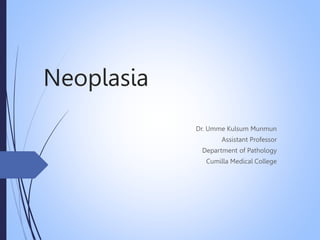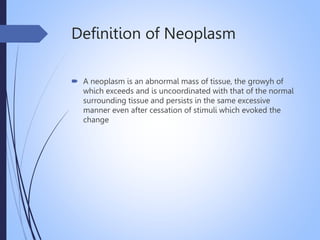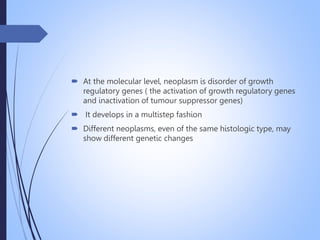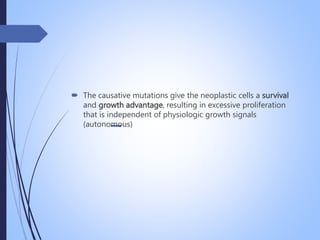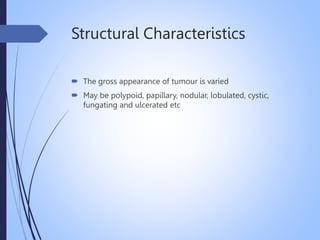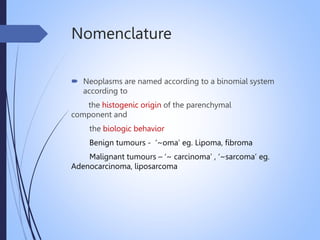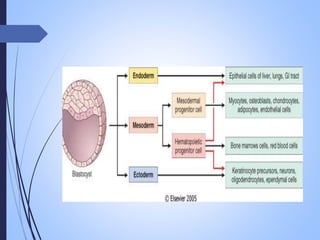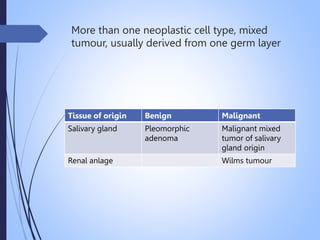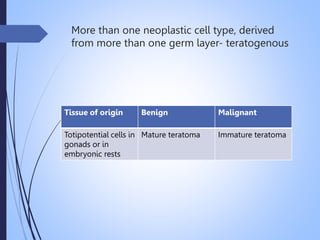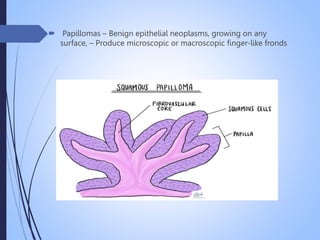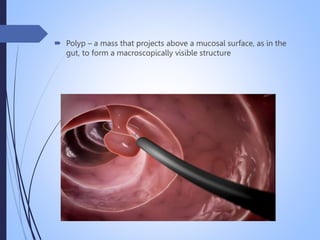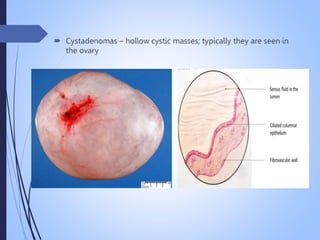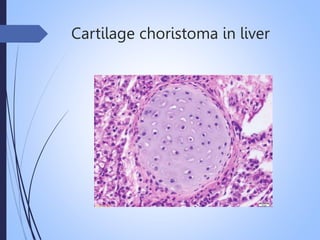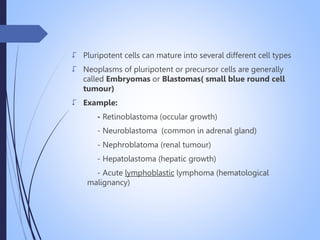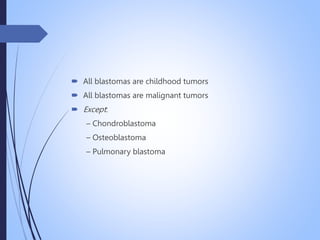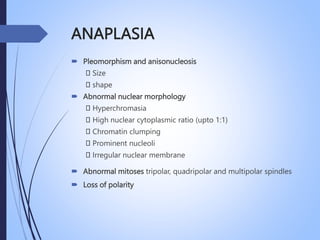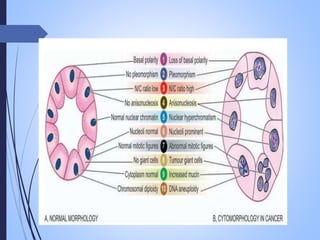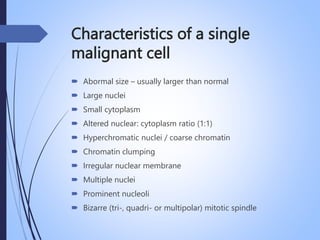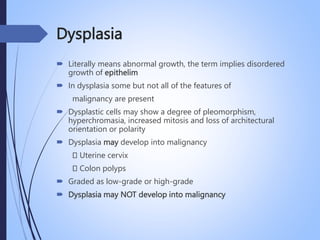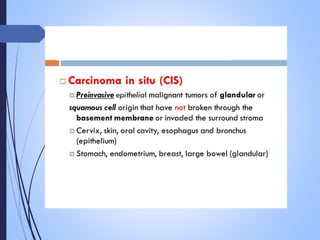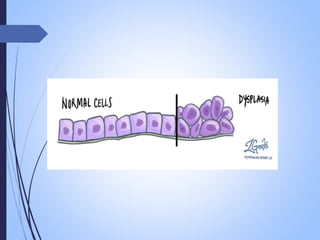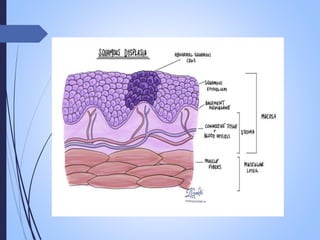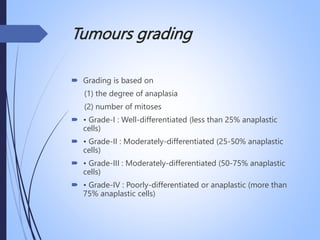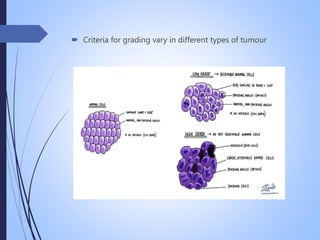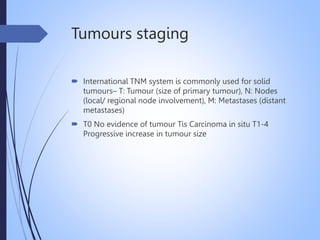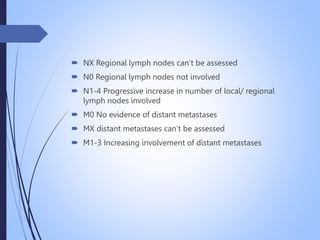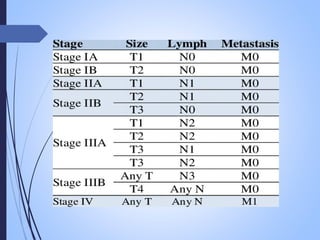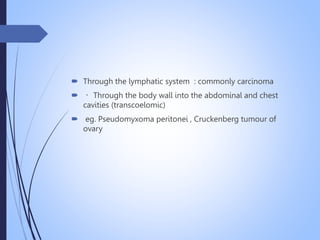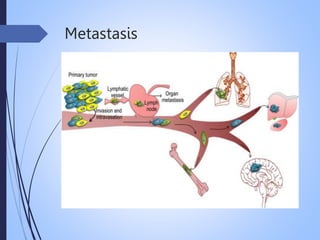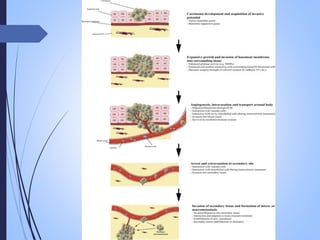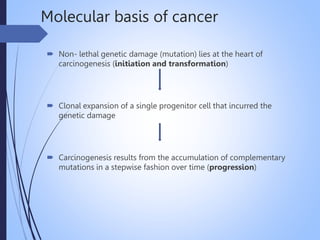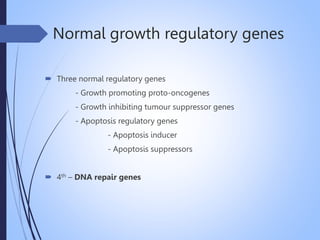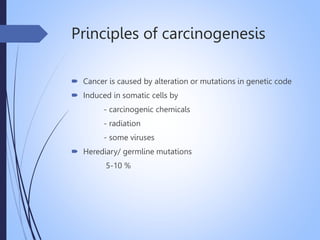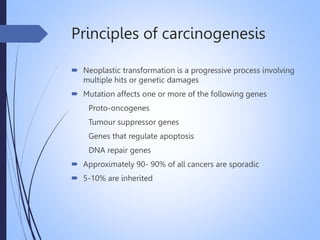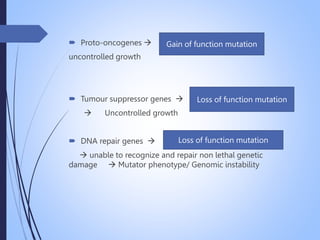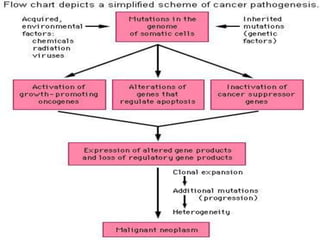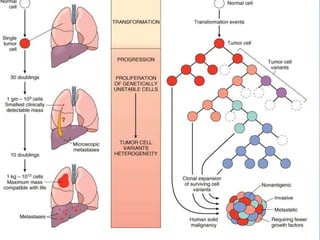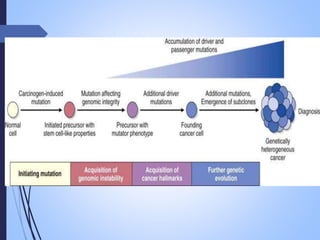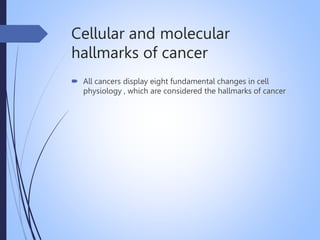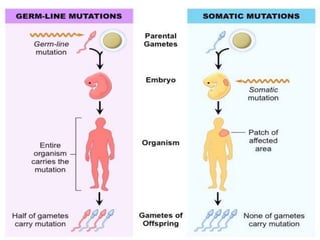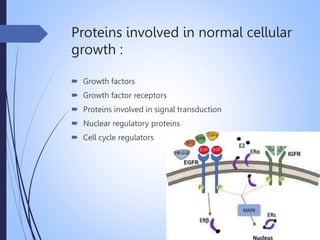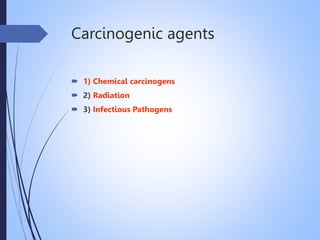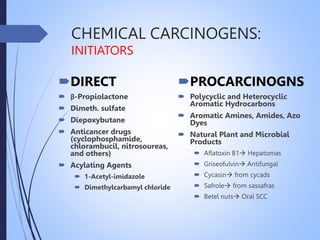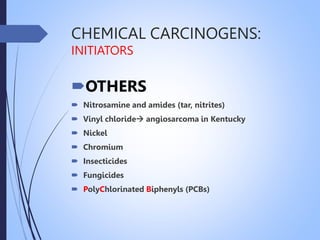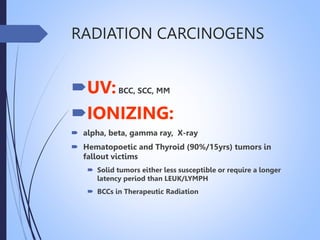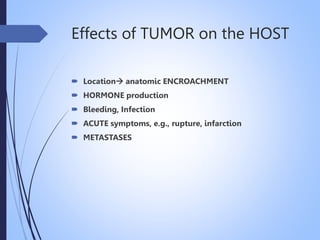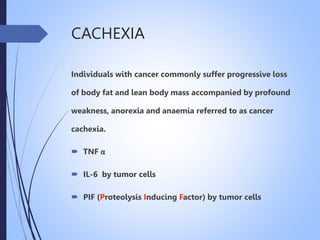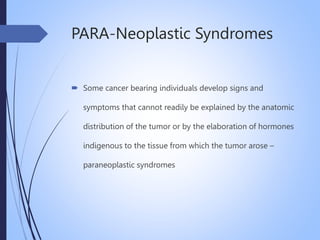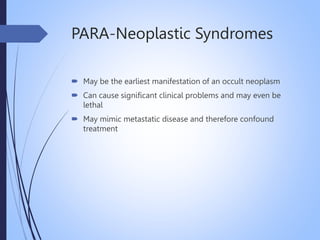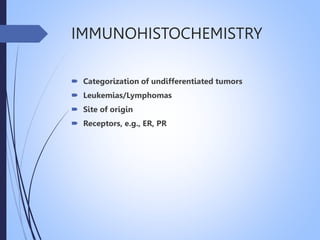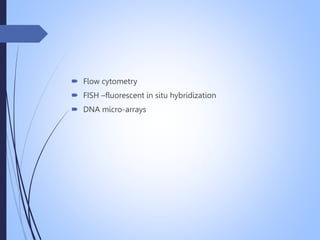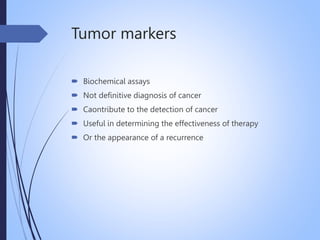neoplasia , carcinogenesis, tumour market
- 1. Neoplasia Dr. Umme Kulsum Munmun Assistant Professor Department of Pathology Cumilla Medical College
- 2. Definition of Neoplasm ’é┤ A neoplasm is an abnormal mass of tissue, the growyh of which exceeds and is uncoordinated with that of the normal surrounding tissue and persists in the same excessive manner even after cessation of stimuli which evoked the change
- 3. ’é┤ At the molecular level, neoplasm is disorder of growth regulatory genes ( the activation of growth regulatory genes and inactivation of tumour suppressor genes) ’é┤ It develops in a multistep fashion ’é┤ Different neoplasms, even of the same histologic type, may show different genetic changes
- 4. ’é┤ The causative mutations give the neoplastic cells a survival and growth advantage, resulting in excessive proliferation that is independent of physiologic growth signals (autonomous)
- 5. Structural Characteristics ’é┤ The gross appearance of tumour is varied ’é┤ May be polypoid, papillary, nodular, lobulated, cystic, fungating and ulcerated etc
- 6. ’é┤ Two basic components of tumoursŌĆö ŌĆó Parenchyma ŌĆō made up of proliferating neoplastic cells, largely determines the biologic behaviors of the tumour. The classification, nomenclature and histological diagnosis are also made according to the parenchymal cells ŌĆó Supporting stroma ŌĆō made up of connective tissue, blood vessels and lymphatics
- 9. Biological Behavior ’é┤ Benign ’é┤ Malignant
- 10. Nomenclature ’é┤ Neoplasms are named according to a binomial system according to the histogenic origin of the parenchymal component and the biologic behavior Benign tumours - ŌĆś~omaŌĆÖ eg. Lipoma, fibroma Malignant tumours ŌĆō ŌĆś~ carcinomaŌĆÖ , ŌĆś~sarcomaŌĆÖ eg. Adenocarcinoma, liposarcoma
- 13. More than one neoplastic cell type, mixed tumour, usually derived from one germ layer Tissue of origin Benign Malignant Salivary gland Pleomorphic adenoma Malignant mixed tumor of salivary gland origin Renal anlage Wilms tumour
- 14. More than one neoplastic cell type, derived from more than one germ layer- teratogenous Tissue of origin Benign Malignant Totipotential cells in gonads or in embryonic rests Mature teratoma Immature teratoma
- 15. ’é┤ Adenoma ŌĆō benign epithelial neoplasms producing gland patterns ŌĆō derived from glands but not necessarily exhibiting gland patterns
- 16. ’é┤ Papillomas ŌĆō Benign epithelial neoplasms, growing on any surface, ŌĆō Produce microscopic or macroscopic finger-like fronds
- 17. ’é┤ Polyp ŌĆō a mass that projects above a mucosal surface, as in the gut, to form a macroscopically visible structure
- 18. ’é┤ Cystadenomas ŌĆō hollow cystic masses; typically they are seen in the ovary
- 20. Lipoma
- 21. Tumours with Aberrant differentiation (Not true neoplasm) ’é┤ A hamartoma is composed of tissues that are normally present in the organ in which the tumor arises ŌĆō Eg: a hamartoma of the lung consists of disorganized mass of bronchial epithelium and cartilage that may become so large that it presents as a lung mass. Its growth is coordinated with that of the lung itself ’é┤ A choristoma resembles a hamartoma but contains tissues that are not normally present in its site of origin ŌĆō Eg: A orderly mass of pancreatic acini and ducts in the wall of the stomach is properly called a choristoma.
- 22. Cartilage choristoma in liver
- 23. ’ĆŠ Pluripotent cells can mature into several different cell types ’ĆŠ Neoplasms of pluripotent or precursor cells are generally called Embryomas or Blastomas( small blue round cell tumour) ’ĆŠ Example: - Retinoblastoma (occular growth) - Neuroblastoma (common in adrenal gland) - Nephroblatoma (renal tumour) - Hepatolastoma (hepatic growth) - Acute lymphoblastic lymphoma (hematological malignancy)
- 24. ’é┤ All blastomas are childhood tumors ’é┤ All blastomas are malignant tumors ’é┤ Except: ŌĆō Chondroblastoma ŌĆō Osteoblastoma ŌĆō Pulmonary blastoma
- 25. Benign vs Malignant Features Features Benign Malignant Rate of growth Progressive but slow. Mitoses few and normal Variable. Mitoses more frequent and may be abnormal Differentiation Well differentiated Well differentiated to various degrees of anaplasia Capsule Common Less common Local invasion Metastasis Cohesive growth. Capsule & BM not breached Absent Poorly cohesive and infiltrative May occur
- 26. Differentiation and Anaplasia ’é┤ ŌĆśDifferentiationŌĆÖ denotes to the degree to which a neoplastic cell resembles the normal mature cells of the tissue both morphologically and functionally ’é┤ Benign tumours are usually well differentiated. They resemble closely their normal counterpart ’é┤ Malignant tumours on the other hand, show variable degree of differentiation
- 27. ’é┤ Malignant tumours that are composed of undifferentiated cells are said to be anaplastic, that means no morphological resemblance to normal tissue ’é┤ ŌĆśAnaplasiaŌĆÖ denotes to the lack of differentiation
- 28. ANAPLASIA ’é┤ Pleomorphism and anisonucleosis Size shape ’é┤ Abnormal nuclear morphology Hyperchromasia High nuclear cytoplasmic ratio (upto 1:1) Chromatin clumping Prominent nucleoli Irregular nuclear membrane ’é┤ Abnormal mitoses tripolar, quadripolar and multipolar spindles ’é┤ Loss of polarity
- 30. Characteristics of a single malignant cell ’é┤ Abormal size ŌĆō usually larger than normal ’é┤ Large nuclei ’é┤ Small cytoplasm ’é┤ Altered nuclear: cytoplasm ratio (1:1) ’é┤ Hyperchromatic nuclei / coarse chromatin ’é┤ Chromatin clumping ’é┤ Irregular nuclear membrane ’é┤ Multiple nuclei ’é┤ Prominent nucleoli ’é┤ Bizarre (tri-, quadri- or multipolar) mitotic spindle
- 31. Features of Malignant Tumors ’é┤ Cellular features ’é┤ Local invasion ’é┤ Malignant: expand, invade and infiltrate the surrounding tissue (basement membrane) Whereas Benign tumours expand and push aside without invading, infiltrating surrounding capsule or basement membrane ’é┤ Metastasis Unequivocal sign of malignancy
- 33. Dysplasia ’é┤ Literally means abnormal growth, the term implies disordered growth of epithelim ’é┤ In dysplasia some but not all of the features of malignancy are present ’é┤ Dysplastic cells may show a degree of pleomorphism, hyperchromasia, increased mitosis and loss of architectural orientation or polarity ’é┤ Dysplasia may develop into malignancy Uterine cervix Colon polyps ’é┤ Graded as low-grade or high-grade ’é┤ Dysplasia may NOT develop into malignancy
- 37. Tumours grading ’é┤ Grading is based on (1) the degree of anaplasia (2) number of mitoses ’é┤ ŌĆó Grade-I : Well-differentiated (less than 25% anaplastic cells) ’é┤ ŌĆó Grade-II : Moderately-differentiated (25-50% anaplastic cells) ’é┤ ŌĆó Grade-III : Moderately-differentiated (50-75% anaplastic cells) ’é┤ ŌĆó Grade-IV : Poorly-differentiated or anaplastic (more than 75% anaplastic cells)
- 38. ’é┤ Criteria for grading vary in different types of tumour
- 39. Tumours staging ’é┤ International TNM system is commonly used for solid tumoursŌĆō T: Tumour (size of primary tumour), N: Nodes (local/ regional node involvement), M: Metastases (distant metastases) ’é┤ T0 No evidence of tumour Tis Carcinoma in situ T1-4 Progressive increase in tumour size
- 40. ’é┤ NX Regional lymph nodes canŌĆÖt be assessed ’é┤ N0 Regional lymph nodes not involved ’é┤ N1-4 Progressive increase in number of local/ regional lymph nodes involved ’é┤ M0 No evidence of distant metastases ’é┤ MX distant metastases canŌĆÖt be assessed ’é┤ M1-3 Increasing involvement of distant metastases
- 42. Natural History Of Malignant Tumors ’é┤ Malignant change in the target cell, referred to as transformation ’é┤ Growth of the transformed cells ’é┤ Local invasion ’é┤ Distant metastases
- 43. METASTASIS ’é┤ Metastasis is the process by which a tumor cell leaves the primary tumor, travels to a distant site via the circulatory system, and establishes a secondary tumor ’é┤ Routes of Metastasis: Mainly 3 types ’é┤ Through the circulatory (blood) system (hematogenous) :Common route for sarcomas but certain carcinomas also frequently metastasiseby this mode. ’é┤ ŌĆóEx: liver, lungs, brain, bones, kidney and adrenals
- 44. ’é┤ Through the lymphatic system : commonly carcinoma ’é┤ Through the body wall into the abdominal and chest cavities (transcoelomic) ’é┤ eg. Pseudomyxoma peritonei , Cruckenberg tumour of ovary
- 45. Metastasis
- 47. Locally malignant tumours ’é┤ Groups of malignant tumours that spread only locally by direct infiltration but rarely metastasize ’é┤ Examples: - Basal cell carcinoma of skin - Osteoclastoma/ giant cell tumour of bone - Adamantinoma of jaw - Carcinoid tumour - Astrocytoma of brain - Craniopharyngioma in pituitary fossa
- 48. Molecular basis of cancer ’é┤ Non- lethal genetic damage (mutation) lies at the heart of carcinogenesis (initiation and transformation) ’é┤ Clonal expansion of a single progenitor cell that incurred the genetic damage ’é┤ Carcinogenesis results from the accumulation of complementary mutations in a stepwise fashion over time (progression)
- 49. Normal growth regulatory genes ’é┤ Three normal regulatory genes - Growth promoting proto-oncogenes - Growth inhibiting tumour suppressor genes - Apoptosis regulatory genes - Apoptosis inducer - Apoptosis suppressors ’é┤ 4th ŌĆō DNA repair genes
- 50. Normal Cell Growth ’é┤ Proto-oncogene product leads to cell growth with external stimuli ’é┤ This growth stimuli should be balanced by the products of tumour suppressor genes ’é┤ Any mutated genes will either be repaired by DNA repair genes (maintains genomic integrity) or killed by products of apoptosis regulatory genes
- 51. Principles of carcinogenesis ’é┤ Cancer is caused by alteration or mutations in genetic code ’é┤ Induced in somatic cells by - carcinogenic chemicals - radiation - some viruses ’é┤ Herediary/ germline mutations 5-10 %
- 52. Principles of carcinogenesis ’é┤ Neoplastic transformation is a progressive process involving multiple hits or genetic damages ’é┤ Mutation affects one or more of the following genes Proto-oncogenes Tumour suppressor genes Genes that regulate apoptosis DNA repair genes ’é┤ Approximately 90- 90% of all cancers are sporadic ’é┤ 5-10% are inherited
- 53. ’é┤ Proto-oncogenes ’āĀ ’āĀ uncontrolled growth ’é┤ Tumour suppressor genes ’āĀ ’āĀ Uncontrolled growth ’é┤ DNA repair genes ’āĀ ’āĀ unable to recognize and repair non lethal genetic damage ’āĀ Mutator phenotype/ Genomic instability Gain of function mutation Loss of function mutation Loss of function mutation
- 56. ’é┤ Driver mutations : Mutations that contribute to the development of the malignant phenotype are reffered to as ŌĆśdriver mutationsŌĆÖ. ’é┤ Passenger mutations: Mutations that have no phenotypic consequence, are called ŌĆśpassenger mutationsŌĆÖ ’é┤ The first driver mutation that starts a cell on the path to malignancy is termed ŌĆśinitiating mutationŌĆÖ
- 57. ’é┤ Initiated cell acquires a number of additional driver mutations , each of which contributes to the development of cancer ’é┤ Mutation in DNA repair genes is a common early step on the road to malignancy , it leads to genomic instability ’é┤ By the time a cell acquires all of the driver mutations needed for malignant behavior, it may bear hundreds or even thousands of additional mutations (tumour progression, diagnosis)
- 59. Cellular and molecular hallmarks of cancer ’é┤ All cancers display eight fundamental changes in cell physiology , which are considered the hallmarks of cancer
- 60. Hallmarks ’é┤ Self ŌĆō sufficiency in growth signals ’é┤ Insensitivity to growth inhibitory signals ’é┤ Altered cellular metabolism ’é┤ Evasion of metastasis ’é┤ Limitless replicative potential (immortality) ’é┤ Sustained angiogenesis ’é┤ Ability to invade and metastasize ’é┤ Ability to evade the host immune response
- 61. ’é┤ Germline mutations are changes to your DNA that you inherit from the egg and sperm cells during conception. ’é┤ Somatic mutations are changes to your DNA that happen after conception to cells other than the egg and sperm. Mutations can lead to genetic conditions and familial cancer syndromes.
- 63. Proteins involved in normal cellular growth : ’é┤ Growth factors ’é┤ Growth factor receptors ’é┤ Proteins involved in signal transduction ’é┤ Nuclear regulatory proteins ’é┤ Cell cycle regulators
- 67. Carcinogenic agents ’é┤ 1) Chemical carcinogens ’é┤ 2) Radiation ’é┤ 3) Infectious Pathogens
- 68. CHEMICAL CARCINOGENS: INITIATORS ’é┤DIRECT ’é┤ ╬▓-Propiolactone ’é┤ Dimeth. sulfate ’é┤ Diepoxybutane ’é┤ Anticancer drugs (cyclophosphamide, chlorambucil, nitrosoureas, and others) ’é┤ Acylating Agents ’é┤ 1-Acetyl-imidazole ’é┤ Dimethylcarbamyl chloride ’é┤PROCARCINOGNS ’é┤ Polycyclic and Heterocyclic Aromatic Hydrocarbons ’é┤ Aromatic Amines, Amides, Azo Dyes ’é┤ Natural Plant and Microbial Products ’é┤ Aflatoxin B1’āĀ Hepatomas ’é┤ Griseofulvin’āĀ Antifungal ’é┤ Cycasin’āĀ from cycads ’é┤ Safrole’āĀ from sassafras ’é┤ Betel nuts’āĀ Oral SCC
- 69. CHEMICAL CARCINOGENS: INITIATORS ’é┤OTHERS ’é┤ Nitrosamine and amides (tar, nitrites) ’é┤ Vinyl chloride’āĀ angiosarcoma in Kentucky ’é┤ Nickel ’é┤ Chromium ’é┤ Insecticides ’é┤ Fungicides ’é┤ PolyChlorinated Biphenyls (PCBs)
- 70. CHEMICAL CARCINOGENS: PROMOTERS ’é┤ HORMONES ’é┤ PHORBOL ESTERS (TPA), activate kinase C ’é┤ PHENOLS ’é┤ DRUGS, many
- 71. RADIATION CARCINOGENS ’é┤UV:BCC, SCC, MM ’é┤IONIZING: ’é┤ alpha, beta, gamma ray, X-ray ’é┤ Hematopoetic and Thyroid (90%/15yrs) tumors in fallout victims ’é┤ Solid tumors either less susceptible or require a longer latency period than LEUK/LYMPH ’é┤ BCCs in Therapeutic Radiation
- 72. VIRAL CARCINOGENESIS ’é┤ HPV’āĀ SCC ’é┤ EBV’āĀ Burkitt Lymphoma, NPC, Hodgkin lymphoma ’é┤ HBV’āĀ Hepatocellular Carcinoma (Hepatoma) ’é┤ HTLV1’āĀ T-Cell Malignancies ’é┤ KSHV’āĀ Kaposi Sarcoma (HHV-8)
- 73. H. pylori CARCINOGENESIS ’é┤ Gastric lymphomas (i.e., M.A.L.T.-omas) ’é┤ Gastric CARCINOMAS
- 74. HOST DEFENSES ’é┤ IMMUNE SURVEILLENCE CONCEPT ’é┤ CD8+ T-Cells ’é┤ NK cells ’é┤ MACROPHAGES ’é┤ ANTIBODIES
- 76. How do tumor cells escape immune surveillance? ’é┤ Mutation, like microbes, like ŌĆ£evolutionŌĆØ ’é┤Ōåō MHC molecules on tumor cell surface ’é┤ Lack of CO-stimulation molecules, e.g., (CD28, ICOS), not just Ag-Ab recognition ’é┤ Immunosuppressive agents ’é┤ Antigen masking ’é┤ Apoptosis of cytotoxic T-Cells (CD8)
- 77. Effects of TUMOR on the HOST ’é┤ Location’āĀ anatomic ENCROACHMENT ’é┤ HORMONE production ’é┤ Bleeding, Infection ’é┤ ACUTE symptoms, e.g., rupture, infarction ’é┤ METASTASES
- 78. CACHEXIA Individuals with cancer commonly suffer progressive loss of body fat and lean body mass accompanied by profound weakness, anorexia and anaemia referred to as cancer cachexia. ’é┤ TNF ╬▒ ’é┤ IL-6 by tumor cells ’é┤ PIF (Proteolysis Inducing Factor) by tumor cells
- 79. PARA-Neoplastic Syndromes ’é┤ Some cancer bearing individuals develop signs and symptoms that cannot readily be explained by the anatomic distribution of the tumor or by the elaboration of hormones indigenous to the tissue from which the tumor arose ŌĆō paraneoplastic syndromes
- 80. PARA-Neoplastic Syndromes ’é┤ May be the earliest manifestation of an occult neoplasm ’é┤ Can cause significant clinical problems and may even be lethal ’é┤ May mimic metastatic disease and therefore confound treatment
- 81. ENDOCRINE
- 82. ’é┤ Nerve/Muscle, e.g., myasthenia w. lung ca. ’é┤ Skin: e.g., acanthosis nigricans, dermatomyositis ’é┤ Bone/Joint/Soft tissue: HPOA (Hypertrophic Pulmonary OsteoArthropathy) ’é┤ Vascular: Trousseau, Endocarditis ’é┤ Hematologic: Anemias ’é┤ Renal: e.g., Nephrotic Syndrome
- 83. LAB DIAGNOSIS ’é┤ CYTOLOGY: (exfoliative) ’é┤ CYTOLOGY: (FNA, Fine Needle Aspirate) ’é┤ BIOPSY (gold standard)
- 84. IMMUNOHISTOCHEMISTRY ’é┤ Categorization of undifferentiated tumors ’é┤ Leukemias/Lymphomas ’é┤ Site of origin ’é┤ Receptors, e.g., ER, PR
- 85. ’é┤ Flow cytometry ’é┤ FISH ŌĆōfluorescent in situ hybridization ’é┤ DNA micro-arrays
- 86. Tumor markers ’é┤ Biochemical assays ’é┤ Not definitive diagnosis of cancer ’é┤ Caontribute to the detection of cancer ’é┤ Useful in determining the effectiveness of therapy ’é┤ Or the appearance of a recurrence
- 88. THANK YOU
- 89. TUMOR MARKERS ’é┤ HORMONES: (Paraneoplastic Syndromes) ’é┤ ŌĆ£ONCOŌĆØFETAL: AFP, CEA ’é┤ ISOENZYMES: PAP, NSE ’é┤ PROTEINS: PSA, PSMA (ŌĆ£MŌĆØ = ŌĆ£membraneŌĆØ) ’é┤ GLYCOPROTEINS: CA-125, CA-195, CA-153 ’é┤ MOLECULAR: p53, RAS ’é┤ NOTE: These SAME substances which can be measured in the blood, also can be stained by immunochemical methods in tissue
